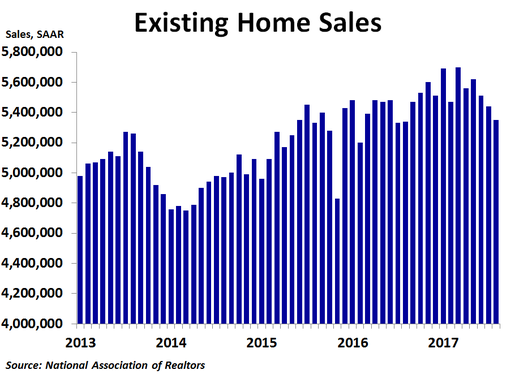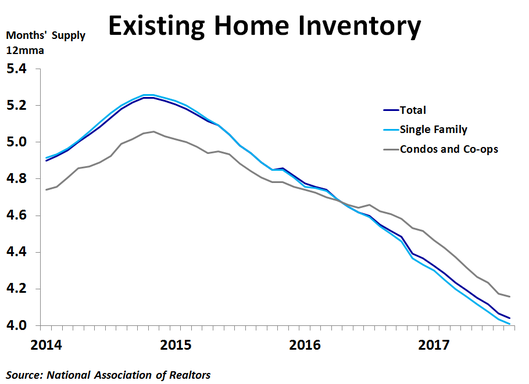Existing home sales fell in August to 5.35 million units on a seasonally adjusted annualized basis, down from July’s 5.44 million units, less than the consensus forecast of 5.48 million units and the lowest reading since last August. Sales were down 1.7% from the prior month and were up just 0.2% from a year ago, also the lowest reading since last August.
By region, sales increased 10.8% from the prior month in the Northeast and 2.4% in the Midwest, but fell 4.8% in the West and 5.7% in the South. Compared to a year ago, sales were up the most in the Northeast at 1.4% and were up 0.8% in both the West and Midwest. Sales were down 0.9% in the South. Although weakness in the South could be partly due to Hurricane Harvey, the South has been on a downward trend for the last few months. Median prices were up the most in the West at 7.7% compared to a year ago, while they were up 5.6% in the Northeast, 5.4% in the South and 5.0% in the Midwest. The national median price was up 5.6%, down from July’s 6.1% rate of growth and the least since December.
By type, sales were up 1.7% compared to the prior month for condos and co-ops but down 2.1% for single-family homes. On a year-ago basis, sales were up 0.4% for single-family homes but down 1.6% for condos and co-ops. Prices were up 5.6% for single-family homes and 5.4% for condos and co-ops.
By type, sales were up 1.7% compared to the prior month for condos and co-ops but down 2.1% for single-family homes. On a year-ago basis, sales were up 0.4% for single-family homes but down 1.6% for condos and co-ops. Prices were up 5.6% for single-family homes and 5.4% for condos and co-ops.
Inventory continues to be a big story right now. In August, inventories fell 2.1%. However, since sales fell a slightly smaller 1.7%, the ratio of inventories to sales, or the months’ supply, held virtually steady at 4.2 for the fourth straight month. However, the 12-month moving average slid to 4.0 months, down significantly from a couple years ago. One big reason that inventories are so low is that some people who would like to upgrade are finding prices too high so they are staying in their current home, preventing others from buying their house and keeping supply limited. What homes do get listed are often scooped up quickly, and sellers are getting multiple offers that in some cases are above the asking price. This suggests we may be close to a cyclical a peak in prices.
Sales fell in August despite mortgage rates staying below 4.0% for a third straight month. With inflation below the Fed’s target of 2.0%, the Fed held rates steady at last week’s meeting. However, they finally gave the market a start date of October for unwinding their balance sheet. This could send mortgage rates higher, but inflation will also be a big factor.
Sales fell in August despite mortgage rates staying below 4.0% for a third straight month. With inflation below the Fed’s target of 2.0%, the Fed held rates steady at last week’s meeting. However, they finally gave the market a start date of October for unwinding their balance sheet. This could send mortgage rates higher, but inflation will also be a big factor.


 RSS Feed
RSS Feed